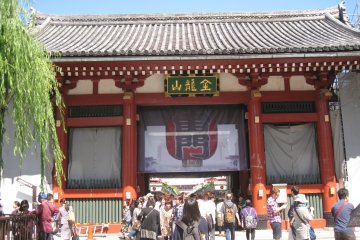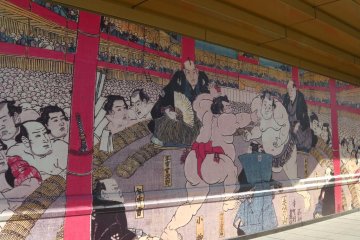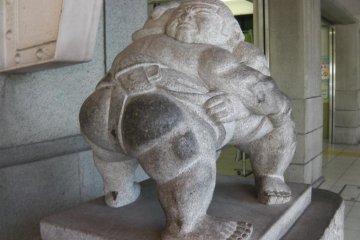Sumo is perhaps the most famous sporting export of Japan. It is in equal parts an awesome athletic display and a tradition-laden spectacle that is sure to please any visitor who happens to catch one of the major tournaments spread throughout the calendar. In Tokyo's famous sumo stadium called the Ryogoku Kokugikan, however, there is more to see than just the matches.
The Sumo Museum (sumo kyokai) is in a small enclave of the stadium, is open year-round, and has free admission. Opened in 1954, it is a well-designed tribute to the famous sport.
The museum's exhibit changes every two months. A visit in November, 2012 revealed a collection of woodblock paintings that date back to the mid-1700's, in the late Tokugawa Period. This style of painting often depicted sumo wrestlers, beautiful women and warriors as themes, and notable artists from this genre include Utagawa Kunisada and Utagawa Kuniyoshi. The collection of paintings was intricate and beautiful, showing legendary sumo wrestlers of a bygone era in action and traditional dress. The museum also included a video detailing the recent promotion of wrestler Harumafuji to yokozuna (the highest rank in the sport), which happened in September, 2012, as well as a portrait wall honoring all 70 wrestlers in history who have attained the yokozuna rank.
However, the museum was a bit underwhelming. A trip through the museum takes no longer than 15 minutes. The room is small and the variety of the displays was limited. Perhaps this would differ according to the current exhibit, but the museum felt more like a nice accessory to a visit during a Grand Sumo Tournament than a tourist destination on its own merit. Tourists are recommended to add this location into a day planned around other events and locales in the area, such as the Edo Tokyo Museum. The area around Ryogoku Station itself has many sumo-related tributes and shops, and sumo wrestlers can be frequently seen walking around the area who may even be willing to pose for a photo if you ask nicely (not only is it polite, but these are not guys you want to have angry at you!).
That said, visitors seeking a taste of Japan's national sport may still enjoy this tasteful and informative tribute. The museum has a respectful awe about it, enhancing the importance of the sport and its heritage. It is a great way to get a little taste of the history and importance of sumo.
The Sumo Museum is open on weekdays from 10:00am-4:30pm. It is not open on weekends or national holidays, unless they fall within a sumo tournament in the same location, and then the museum can be accessed only by attendees to the sumo matches.
Note that photography is not allowed in the Sumo Museum. The photos provided with this article show locations around Ryogoku Kokugikan and Ryogoku Station.













